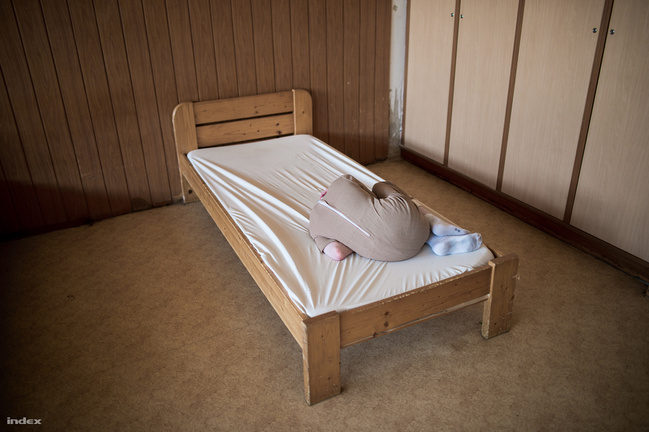
Do you ever wonder how it might feel if your hands, your feet, or your brain did not function like everybody else’s? If you needed help even to roll over from one side to the other, and you could not eat, wash yourself, or go to the toilet alone? Most people are terrified of the thought that someday they might have to experience this extreme vulnerability; they are terrified of the possibility that they might have a child who will never be able to run into their arms, laughing – just like many of us are struck with fear when meeting a disabled person. Though struggling with most problems of the Hungarian disability care system, while nursing 220 children and adults with severe and multiple disabilities, the Topház in Göd is striving to show that even the lives of people with the most severe physical and mental disabilities can be liveable and meaningful, that the connection can be found even to the most autistic child, that the word ‘people’ does not only include smiling, tanned people with 32 teeth.
Approximately 15,000‒18,000 people with severe and multiple disabilities live in Hungary, including 3000‒3500 minors. Disabled people in this category have at least two severe disabilities, so they need support and care all their life. Most of them have severe mobility impairment and cannot speak, and more than three-quarters of them have mental disabilities. They can be considered as one of the most disadvantaged groups even within the Hungarian disabled population.
People with severe and multiple disabilities are cast out by the system from virtually everywhere: they can hardly be admitted even to kindergarten, and they drop out of school very early – assuming they are admitted there in the first place. As adults, they can no longer access the services of day-time institutions and residential facilities, while supportive housing practically is practically non-existent in Hungary. Their subsistence as adults is almost completely unresolved as well. Thus, civil rights organizations say, the biggest problem facing this group is one of complete abandonment, for which the only solution the state has is to gather these completely vulnerable people into mass institutions.
‘I don’t intend to shock you but I know you will be shocked anyway. Many here are in a condition that some people could not even imagine,’ says the director of Topház in Göd, Tamás Formanek, as he opens the door for me to one of the wings of the institution nursing children and adults with severe and multiple disabilities. It is not an exaggeration. At first, the sight is indeed mostly frightening but after the first shock, when we get used to the fact that we see different kinds of bodies here than in everyday life, then we also realize how much the residents smile and with how much effort they try to show as much as possible of their own world. (Photo: János Bődey / Index)
Approximately 15,000‒18,000 people with severe and multiple disabilities live in Hungary, including 3000‒3500 minors. Disabled people in this category have at least two severe disabilities, so they need support and care all their life. Most of them have severe mobility impairment and cannot speak, and more than three-quarters of them have mental disabilities. They can be considered as one of the most disadvantaged groups even within the Hungarian disabled population.
People with severe and multiple disabilities are cast out by the system from virtually everywhere: they can hardly be admitted even to kindergarten, and they drop out of school very early – assuming they are admitted there in the first place. As adults, they can no longer access the services of day-time institutions and residential facilities, while supportive housing practically is practically non-existent in Hungary. Their subsistence as adults is almost completely unresolved as well. Thus, civil rights organizations say, the biggest problem facing this group is one of complete abandonment, for which the only solution the state has is to gather these completely vulnerable people into mass institutions.
‘I don’t intend to shock you but I know you will be shocked anyway. Many here are in a condition that some people could not even imagine,’ says the director of Topház in Göd, Tamás Formanek, as he opens the door for me to one of the wings of the institution nursing children and adults with severe and multiple disabilities. It is not an exaggeration. At first, the sight is indeed mostly frightening but after the first shock, when we get used to the fact that we see different kinds of bodies here than in everyday life, then we also realize how much the residents smile and with how much effort they try to show as much as possible of their own world. (Photo: János Bődey / Index)

The Topház in Göd, operating in the former Schöffer Mansion, is an unconventional institution in many ways but its peculiarity derives exactly from the characteristics of the poorly organized system. Pursuant to the de-institutionalization strategy aimed at the termination of big residential facilities caring for disabled people, it could not be that big ‒ it has 220 residents, aged from 18 months to 50 years ‒ and due to recent reforms, officially no education may be organized in it either. So the employees of the institution do their best to create liveable lives for the residents at the intersection of problems affecting education and social care systems. ‘If we sat down to take into account all the problems regarding functioning, we would not even feel like living. So it cannot be dealt with that way; but it must be done, we have to go forward,’ the director said. (Photo: János Bődey / Index)
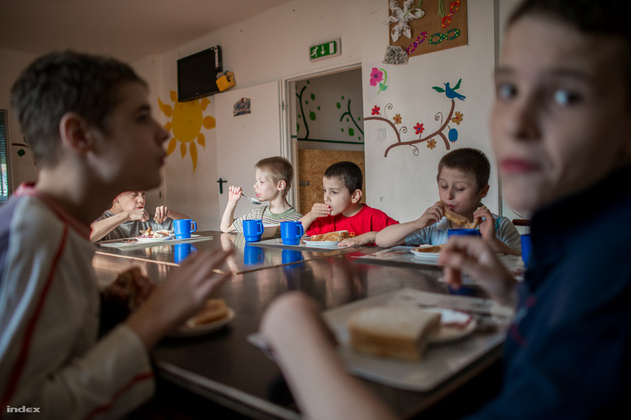
Many small children go to Göd directly from the hospital after their birth: their parents simply leave them there. At first, this may sound brutal and cruel but Formanek says we must not condemn these parents either. ‘Who would not be terrified if a small child could only be fed through a nose probe? Very few people think that they would have the ability for this level of nursing, and such severe cases that would ruin the whole family, both in financial and psychological terms, often arise,’ he said. The small children admitted to Göd can stay in the institution for the rest of their lives. They can also get involved as adults in different work: for instance they help in gardening, laundry services, and keeping the petting zoo clean and tidy. However, no external players participate in their social employment, so even those capable of work cannot be employed outside the walls of the institution. (Photo: János Bődey / Index)
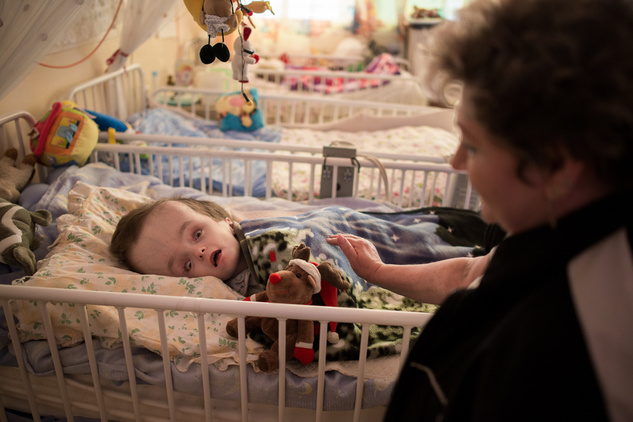
‘The attitude of the majority of people towards disability is like “OK, it is terrible that it exists” but as long as it does not happen to them, they are not really interested. But everyone can have an impaired child, or they themselves can become impaired in an accident so that they get into a condition similar to that of our residents. This is a quantifiable risk but as long as there is no trouble, nobody believes this risk to be real,’ said Formanek. ‘A woman can have the best physician, she can take the best pregnancy vitamins, she can eat the healthiest food ‒ there still remain cases that no geneticist can filter out, and no vitamin can change. The set of problems resulting from all this is what comes to us.’ (Photo: János Bődey / Index)
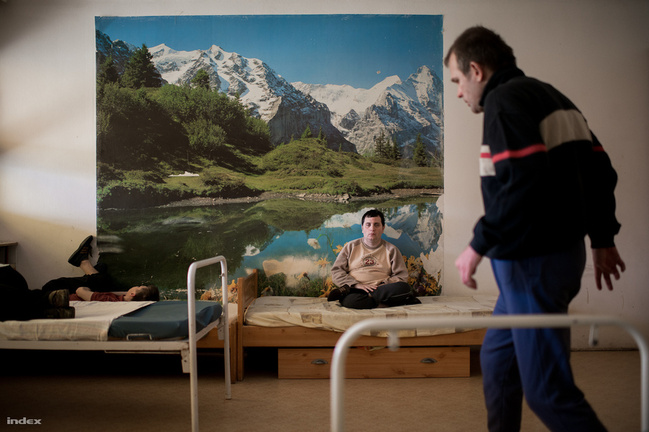
Most residents spend all their lives in Topház; there are only very rare cases when someone is taken back by their families, adopted, or transferred to another social institution. Most residents of the institution are under state care but parents can admit their disabled child to Topház even without renouncing their right to guardianship. This can mean relief in cases where the parents cannot bear the physical and mental burden resulting from continuous nursing but they do not want to make their small child disappear, almost as if “it has not happened”. That’s why the residents can be visited anytime, or the children can even be taken home by their parents for the weekends and holidays. Since only a small number of the residents are visited regularly by their relatives, there are separate visiting rooms in the building, so that the ones to whom nobody ever comes will not be saddened.’ (Photo: János Bődey / Index)

Pursuant to the Education Act of 1993, there is no child that cannot be educated, i.e., everybody is entitled to education. However, in the interpretation of the Hungarian education system, children with severe and multiple disabilities cannot be educated in school circumstances because their physical condition is too poor. This obviously depends on our concept of school: if school was not only a place where children have to sit at their desks taking notes but a place where everybody learns what they need for life, then it would not be so hard to imagine that disabled people could also attend schools. (Photo: János Bődey / Index)

In Topház, the 44 minors are educated individually because the majority are confined to bed. Although within the current system, the education of these children seems basically unsolvable, this method is against the rules within the current framework: since 2011,educational activities can only be performed in a public education institution. However, an institution caring for severely disabled people does not belong to this category but to that of social institutions. The special education teachers working there are not treated by the system as normal teachers either, which is also manifested in the fact that they were not involved in the pay rise of last year. (Photo: János Bődey / Index)
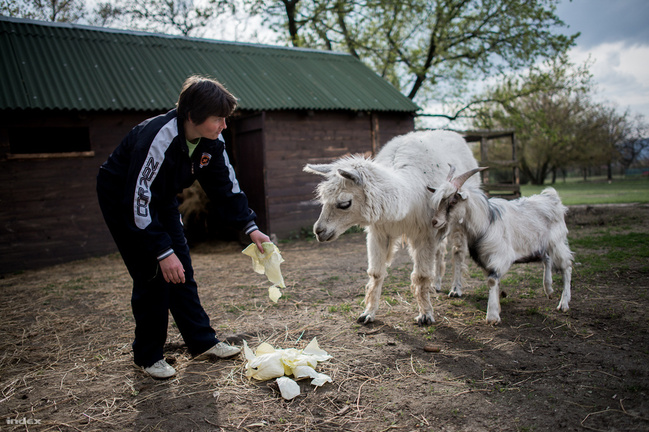
Education in Topház is obviously totally different than in an average school. On the one hand, children here are not taught how to read and write but to eat, keep clean, brush their teeth, and other essential things. On the other hand, education is much more personal than it is when a teacher stands by their desk and tries to transfer knowledge, without knowing if they managed to get through to their audience. With disabled children, teachers try to communicate through all their senses, even through smell, light, and touch but the least with words. It is immediately visible on the student if certain information has got through. Children often need to be directed to the right movement with guidance and touch; that’s why there is a much more direct relationship between teacher and student. Furthermore, every development plan is designed in an individualized manner, adjusted to the given child’s abilities. (Photo: János Bődey / Index)
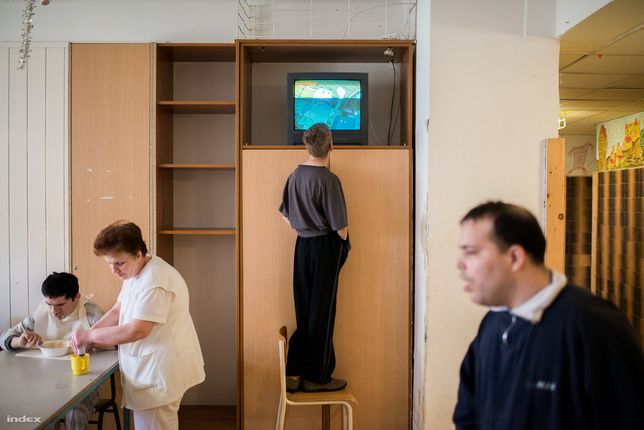
The basic idea of special education is that everyone should be given the chance to develop, and the key for development should be found even in the case of disabled children with the most severe conditions. ‘The brain is an amazing invention of nature, since if a proportion of its cells die, the rest is able to take over their functions, provided they are taught how to do so,’ the director explained. Therefore, special education does not set levels or milestones to achieve, and instead of concentrating on what the child is not capable of, it focuses on the things the child may be able to do and then builds on their skills. There are no set milestones or levels to achieve, but it is always a great experience of success if the child can manage to solve a task. Beyond developmental activities, the residents, children, and adults alike, take trips and go to the theatre on a regular basis. Some of them also go cycling. From many aspects, even taking a trip means exceeding some boundaries, as outsiders start wondering why disabled people do things like that. ‘Why on earth should not we take trips?’ Formanek wonders. (Photo: János Bődey / Index)
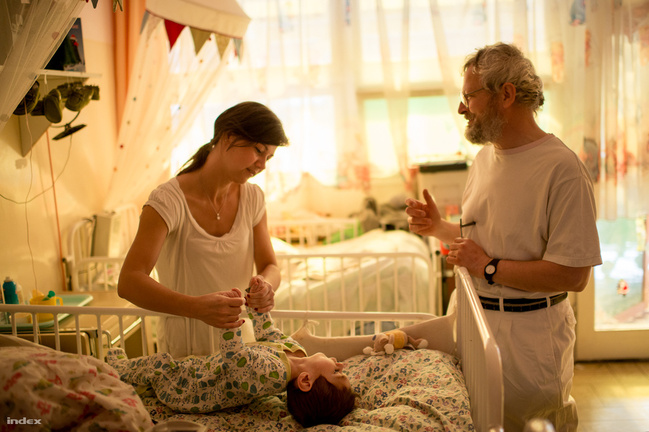
Development and education in isolated institutions has its drawbacks as well, even though it does not seem possible for many children at first to get regular development elsewhere. According to civil rights organizations such as TASZ (the Hungarian Civil Liberties Union), the biggest problem is caused by the fact that in most cases, parents of children with severe and multiple disabilities have to choose between providing an education to their child or raising them at home, as development is not possible at the nearby schools, and there are only a few special institutions in the country. The splitting up of the family traumatizes the children, while the parents often battle with remorse for putting their child into an institution for life. (Photo: János Bődey / Index)
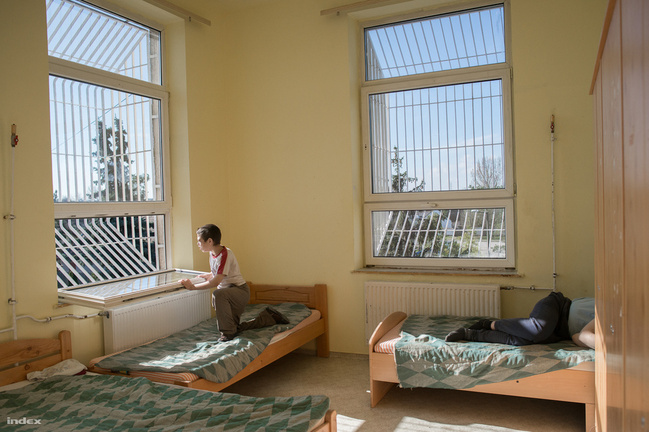
The atmosphere in Topház reflects neither the underlying bureaucratic fight, nor the fact that proportionally there are fewer caregivers in the institution, due to statutory regulation, than would be necessary compared to the severity of the condition of the great number of residents. Despite all this, Topház aims to function as a big family. Thus, the rooms are not separated according to age; another advantage of which is that the older ones can provide help for the young ones and the more able ones for the less able ones. In principle, some of the activities take place separately, but why should an adult not listen to the tale read for the smaller ones? (Photo: János Bődey / Index)

Currently, in compliance with EU trends, a de-institutionalization strategy is in effect in Hungary lasting until 2041, i.e., disabled and psychiatric patients should be placed in small residential homes or integrated into society in some other way by this date. The most common objection against these huge institutions is that such a large number of people simply cannot feel comfortable together, Formanek explained. However, according to the employees of Topház, the closeness of the others is not bothersome for the residents; moreover, since most of them have great difficulty with communicating with the outside world, the relationships within the institution gain more importance for them. (Photo: János Bődey / Index)

Besides the mansion building, a residential home also functions in Topház, where those people who are able to cope with their condition and accomplish their own needs to some extent are placed. However, such a residential home is not a possibility for many of the people with severe and multiple disabilities because of their inability to care for themselves. In their case, the aim is the development of caregiving close to their home; in other words that their parents be provided with special help regarding nursing and childcare in their own homes on a regular basis. Under current Hungarian circumstances, this seems to be a distant utopian goal. (Photo: János Bődey / Index)
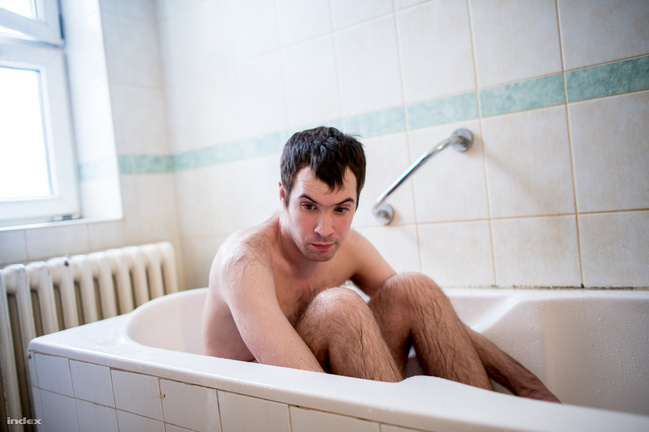
The integration of people with severe mental disabilities is also difficult because of the lack of a uniform symbol which could indicate the nature of their condition; for example, a wheelchair in connection with the physically disabled or a white stick in the case of the blind. Whilst many people don’t like using a white stick or a wheelchair precisely because of their stigmatizing effect, according to Formanek, these tools help the majority to assess how they may and should treat a wheelchair user or a blind person. There is no such clue in the case of mentally disabled people; many do not even know what this condition really means, and thus they are unable to cope with the situation. (Photo: János Bődey / Index)
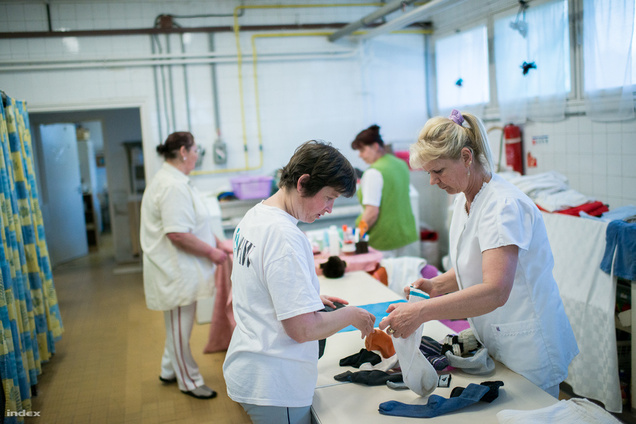
Nonetheless, integration is of utmost importance also for the residents of great institutions living completely isolated from the rest of society. ‘Integration depends not only on the receiving society but also on what we do to achieve it,’ the director said. Therefore, the caregivers try to escort the residents of Topház shopping as often as possible, and they attend events held in Göd and the vicinity as well. For example, they had a great success last summer at the Dunakeszi Festival with their dance performance. By the way, Topház enjoys good relations with the locals, many of whom provide help to the house with voluntary work, and the local papers also regularly publish articles on the institution, which is also of great help with regard to integration and acceptance of the residents. (Photo: János Bődey / Index)
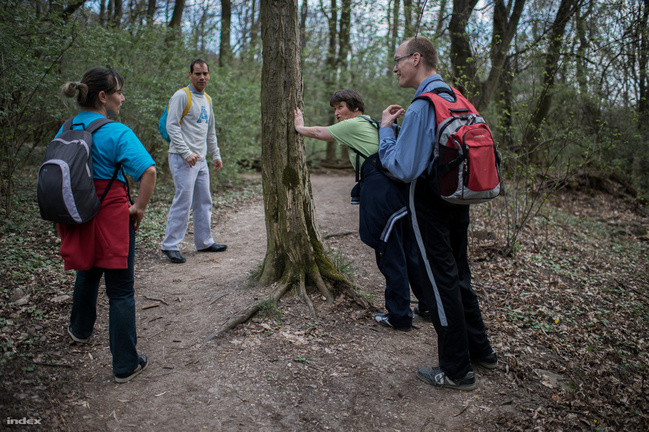
As people with severe and multiple disabilities are forced to express themselves from a very early age without every-day communication tools ‒ many of them cannot even cry as babies to express their needs ‒ they usually try to bridge the gap between their need to connect and their ability to communicate in a way which is incomprehensible to their environment, and which may seem unintelligible or even repellent at first. (Photo: János Bődey / Index)

Many of the people who have visited Topház ask why these people live at all and what the point is in such a life. ‘I think no one should ever ask such questions about the life of another person. How can you decide whose life is more valuable? On what grounds can anyone state that the life of a man sitting all day long in the pub spending his life in alcoholic delusion is more valuable than that of any of our residents? However, while I do not condemn my alcoholic fellowmen, many people question the point of existence of the severely disabled,’ the director explained. (Photo: János Bődey / Index)

‘In my opinion, the greatest value of institutions like Topház is that those visiting such places cannot help re-evaluating and reconsidering the notion they have formed about people. One has to realize that there are not only smiling, blonde, tanned people with 32 teeth in the world,’ Formanek said. (Photo: János Bődey / Index)
Originally published in Hungarian in May 2014 on Index.hu
Text by Anna Csonka
Photos by János Bődey
Translated by TRM
Text by Anna Csonka
Photos by János Bődey
Translated by TRM
 RSS Feed
RSS Feed
